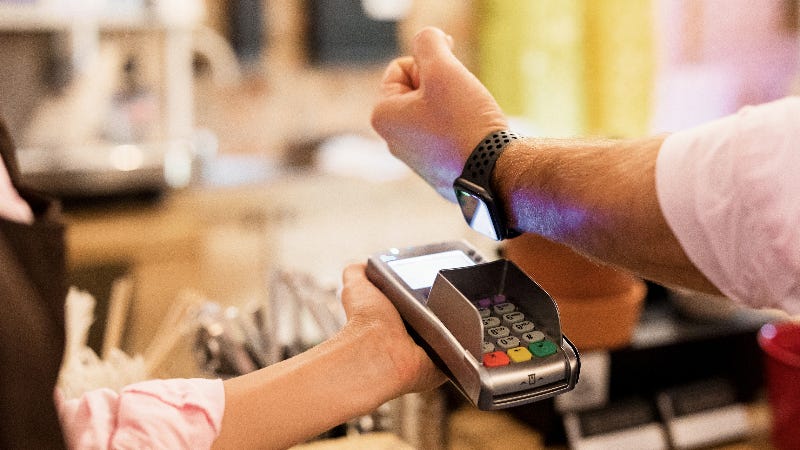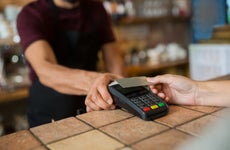How integrated payments are evolving with connected devices

The Bankrate promise
At Bankrate we strive to help you make smarter financial decisions. While we adhere to strict , this post may contain references to products from our partners. Here's an explanation for . The content on this page is accurate as of the posting date; however, some of the offers mentioned may have expired. Terms apply to the offers listed on this page. Any opinions, analyses, reviews or recommendations expressed in this article are those of the author’s alone, and have not been reviewed, approved or otherwise endorsed by any card issuer.
Many people have already become accustomed to paying with a mobile wallet or storing card information on a website to quickly hit “Buy Now” at checkout, but there’s a new purchasing frontier that Americans are beginning to catch on to: connected device payments.
Payments that are integrated into our lives and activities, like buying dish soap by voice command while loading the dishwasher or paying for coffee by simply holding your watch near the barista’s point-of-sale terminal are becoming more and more commonplace for Americans.
Like with any new payment technology, there are security risks to be aware of and protect yourself from, but as these technologies develop, our checkout experiences will become much more seamless and even sanitary, as handling actual cash and cards becomes less necessary.
Here’s everything you need to know about evolving payments via connected devices.
Wearables
Next time you hit the gym or run errands, consider the convenience of leaving not only your wallet at home, but your phone too.
According to research firm CCS Insight’s most recent wearables research service, the adoption of smartwatches, smart wearables, fitness bands and other wearable devices is expected to continually grow over the next few years, predicting that shipments of wrist-worn devices will exceed 400 million in 2026, increasing by 73 percent from 2021. Last year proved to be a strong year for smartwatches and fitness trackers with a 20 percent rise in wearables shipments and record Apple Watch sales. CSS estimates that 232 million wearables were shipped in 2021.
While Apple Watches are among the most common of these devices, models from brands like Fitbit, Garmin, Fossil and Huawei are all experiencing the same growth.
Initially, the lack of retailers making the switch to point-of-sale terminals able to accept near-field communication or NFC-enabled payments (the same terminals that are designed to accept your contactless credit cards) was a hurdle for smartwatch wearers. According to Visa, nearly 20 percent of all in-person credit or debit card transitions in the U.S. are contactless. That is a relatively low number in comparison to nations like Australia where, in 2017, 92 percent of in-store Visa transactions were contactless.
If you have a smartwatch or other smart device, try connecting your card information to test the technology for yourself.
Voice-connected devices
New payments-based technological innovations are constantly being designed with consumer ease and convenience in mind, which is why it’s no mystery that voice payments are beginning to catch on through devices connected to virtual assistants like Amazon’s Alexa.
According to the 2020 How We Will Pay Study, a collaboration between PYMTS.com and Visa, 32.6 percent of consumers own voice-connected assistants (like Amazon Echo or Google Home) and 6.7 percent made voice-assisted purchases while shopping for groceries or retail goods in the last 24 hours.
Making purchases by voice can be game-changing for multitaskers on the go, as well as those with accessibility needs. The How We Will Pay study found that some people used their voice-connected devices to make purchases while cleaning the house, taking care of a loved one and even cooking.
Cars, appliances and beyond
In-dash automobile payments are another emerging payments environment. In 2018, Chevrolet and Shell teamed up to allow owners of select Chevy models to pull up to the pump at a Shell station, select a form of payment directly from their car’s screen and begin fueling. Similar in-dash payments have since spread to encompass more vehicle brands and types of purchases.
Beyond the auto industry, appliances like Samsung’s Family Hub refrigerator now integrate payments capabilities too, allowing you to shop for groceries straight from the fridge. CCS Insights predicts that smart sports shoes will be the landmark product to pave the way for smart clothing products.
Though the popularity of payment standards such as mobile wallets continues to grow, it’ll likely still be a while before these transactions made via the broader Internet of Things spectrum are fully integrated into our everyday lives.
Are they safe?
While biometric authentication is the standard for protecting these new payment forms (for example, using facial or fingerprint identification for Apple Pay or Google Pay), many people remain wary of biometrics, even when they recognize the convenience.
According to research from Paysafe, 45 percent of consumers avoid biometric payments due to a lack of trust and 35 percent say they are distrustful because they aren’t educated enough.
But beyond its frictionless ease of use, biometrics technology is also one of the safest ways you can pay. Information that is wholly unique to you, whether your fingerprint, your face or your voice, is much more difficult for potential identity thieves to replicate than a password or PIN.
That doesn’t mean biometrics are without risk, though. While you can change a password easily in case of an attempted hack, you can’t change your fingerprint or another biometric identifier as easily. Some experts warn that long-lasting devices within the Internet of Things, like refrigerators or thermostats, may even cause a breeding ground of sorts for hackers looking to infiltrate systems via older models.
What does the future hold?
We’re just beginning to scratch the surface of how emerging technologies will change the ways in which we make transactions.
Experts predict that, in the not-so-distant future, artificial intelligence and biometric authentication will be integrated into nearly every purchase we make, from coffee runs to movie tickets to parking spots and beyond.
Already, we’re seeing a move toward seamless payment integration and a wallet-free society — Amazon’s series of Amazon Go convenience stores (now expanded to a supermarket as well) are completely cashier-less. Instead of waiting in a checkout line, customers scan a mobile app and the store uses sensors to recognize which items are taken from the shelves.
While this may not yet be the norm, it does mark another move toward the integration of smartphones and mobile wallet technology, as well as biometric and device payments that banks and retailers can employ to make checkouts more frictionless and integrated into our daily lives.
As we learned with EMV chip and contactless card payments, it’ll take time for merchants to begin accepting new payment methods. In the meantime, you can start exploring these technologies for yourself as they become available to you through device upgrades and your own implementation.
Related Articles


How Venmo and other payment apps are ushering in a new way to tip

